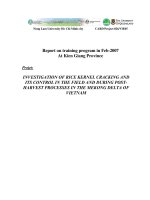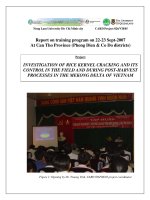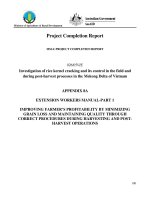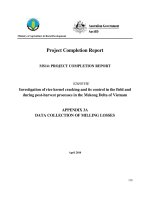Bio-efficacy of post emergence herbicides against weed control in soybean
Bạn đang xem bản rút gọn của tài liệu. Xem và tải ngay bản đầy đủ của tài liệu tại đây (328.28 KB, 11 trang )
Int.J.Curr.Microbiol.App.Sci (2019) 8(4): 1964-1974
International Journal of Current Microbiology and Applied Sciences
ISSN: 2319-7706 Volume 8 Number 04 (2019)
Journal homepage:
Original Research Article
/>
Bio-Efficacy of Post Emergence Herbicides against
Weed Control in Soybean
A. Patel1*, N. Spare1 and G. Malgaya2
1
JNKVV, College of Agriculture, Jabalpur (M.P.) 482004, India
2
NKVV, College of Agriculture, Rewa (M.P.) 48600, India
*Corresponding author:
ABSTRACT
Keywords
Herbicide, Hand
weeding, Weed
control efficiency,
Weed index
Article Info
Accepted:
15 March 2019
Available Online:
10 April 2019
A field experiment was undertaken to assess the bio-efficacy of post emergence herbicides
against weed control in soybean. The predominant weed species in experimental field were
Dinebra retroflexa, Echinocloa colona, Cyperus rotundus Lindernia ciliate and Mullogo
pentaphylla. The maximum suppression of all the weed density, weed biomass and highest
weed control efficiency vis-à-vis crop yield were obtained where twice hand weeding done
at 20 and 40 days after sowing and closely followed by the treatment with
Imazethapyr+Propaquizafop 75.0+62.5 g/ha, Imazethapyr alone at 100 g/ha and
Imazethapyr+Bentazone 75.0+75 g/ha. Whereas weedy check treatment produced lowest
yield of soybean among all the treatment. Highest weed index occurred in weedy check
plots where weeds were not controlled throughout the crop season, among all herbicidal
treatment lowest weed index falls in combination of Imazethapyr + Propaquizafop 75+62.5
g/ha.
Introduction
Soybean (Glycine max L.) is one of the most
important oil seed crop of the country, which
contains 35-40% protein, 19% oil, 35%
carbohydrate, 5% minerals and several other
components including vitamins. In India it is
grown under 11.65 million hectares area with
the production of 8.0 million tonnes. In
Madhya Pradesh it is cultivated under 5.9
million hectare area with production of 4.5
million tonnes (SOPA, 2016). In the state it
grown as Kharif crop, but weed infestation is
the major constraint in soybean produce in
rainy season (Vollmann et al., 2010), it is
heavily infested with grasses, sedges and
broad leaved weeds. During the initial period,
the crop growth is very slow which resulted
vigorous growth of weeds in kharif season.
Thus intense weed competition for nutrients,
sunlight, space and water, reduces the crop
productivity. If weeds are not controlled at
critical stage that is 20-40 DAS period of
crop-weed competition, there may be
identical reduction in the seed yield of
soybean. The yield losses due to uncontrol
weeds are ranging from 31 – 84 % as reported
by Karchoo et al., (2003). According to
1964
Int.J.Curr.Microbiol.App.Sci (2019) 8(4): 1964-1974
Kundu et al., (2011) the loss in yield of
soybean due to weeds was 43% in control
which indicates the necessity of controlling
weed for exploiting the yield potential of
soybean. There are so many herbicides
reported to control weeds in soybean but they
are less effective to control. The preemergence herbicides like alachlor and
metalachlor have been recommended for
weed control in soybean and are being used
by the farmers since long period. Presently,
Imazethapyr is being in use as a postemergence herbicide for controlling weeds in
soybean (Patel et al., 2009). However, its
efficacy has not been tested with
Propaquizafop and Bentazone alone or in
combination for wide spectrum weed control
in soybean. At present, imazethapyr is being
in use as a post-emergence herbicide for
controlling weeds in soybean but some weeds
had reported to uncontrol when imazethapyr
was applied in alone (Patel et al., 2009).
as per norms of National Agriculture
Research Project (NARP), New Delhi. The
monsoon commenced in the first week of July
and terminated in the 1st week of October.
The total rainfall received during the crop
season was 1187 mm, which was equally
distributed in 52 rainy days from July to 2nd
week of October. The maximum rainfall
(263.20 mm) was received in the last week of
August in 6 rainy days. The maximum
temperature was ranged from 27.0°C (in 4th
week of August) to 35.8°C (in the first week
of July). However the minimum temperature
was ranged from 15.4°C (in third week of
October) to 24.9°C (in the first week of July).
Similarly relative humidity ranged between
82 to 94 % in morning and 29 to 91 % in
evening. The sunshine hours varied between
0.0 to 9.3 hours per day. Generally, relative
humidity remains very low during summer
(15 to 30%), moderate during winter (60 to
75%) and attains higher values (80 to 95%)
during rainy season.
Materials and Methods
A field experiment was conducted at
Research farm, Department of Agronomy,
Jawaharlal Nehru Kirshi Vishwa Vidyalaya,
Jabalpur (M.P.) during kharif 2016. The field
selected for experimentation had having
uniform topography and infested with
location specific weeds representing to this
area. The soil of the experimental field was
clay loam in texture, neutral in reaction (7.1),
medium in organic carbon (0.60 %), available
nitrogen (367 kg/ha), available phosphorus
(16.23 kg/ha) and available potassium (317.10
kg/ha) contents.
The climate of experiment field is typically
sub humid, featured by hot dry summer and
cool dry winter. Jabalpur is situated at 230 09'
North latitude and 790 58' East longitudes
with an altitude of 411.78 meters above the
mean sea level. It is classified under "Kymore
Plateau and Satpura Hills" agro- climatic zone
The ten treatments comprising of different
doses of imazethapyr + propaquizafop
(75+62.5 g/ha), imazethapyr + bentazone
(75+75 and 75+62.5 g/ha), propaquizafop
+bentazone (75+75 and 62.5+75 g/ha), and
alone application of imazethapyr (100 g/ha),
propaquizafop (75 g/ha) and bentazone (150
g/ha) as post-emergence, hand weeding twice
at 20 and 40 DAS including weedy check,
were laid out in randomized block design with
3 replications.
Soybean, cv. JS 20-29 was sown manually on
11th July 2016 with the fertilizer dose (20 kg
N + 60 kg P2O5 + 20 kg K2O/ha) was applied
as basal through urea, single super phosphate
and muriate of potash. The whole quantity of
all fertilizers was applied manually at the time
of sowing as basal in the rows at about 2-3 cm
below the seed. The seeds were sown @ 70
kg/ha manually in each experimental plot
keeping a row to row distance of 30 cm at the
1965
Int.J.Curr.Microbiol.App.Sci (2019) 8(4): 1964-1974
depth of 3-4 cm. The spray of herbicides was
done with the help of knap-sack sprayer fitted
with flat fan nozzle using 500 liters of
water/ha. Other practices were adopted as per
the recommendations. Species wise weed
count, weed biomass, weed control efficiency
were recorded after post emergence
application. Finally the crop yield was
measured at the time of harvest. The weed
index (WI) was calculated by using formula:
WI = [(Yield from weed free plot (i.e. hand
weeding) - Yield from the treated plot)* 100/
Yield from weed free plot (i.e. hand
weeding).
Results and Discussion
Weed flora
Five predominant weed species were
observed in experimental field during the
rainy (kharif) season of 2016 (Table 1).
Among the monocot weeds Dinebra
retroflexa was the most dominant weed have
maximum relative density (26.77%) followed
by Echinocloa colona (21.23%) and Cyperus
rotundus (14.46 %), Whereas dicot weeds
contributed 37.54 % to relative density of
weeds, However among the dicot weeds
Lindernia ciliate marked its presence in more
number (25.90 %) as compare to Mullogo
pentaphylla (11.63%) in soybean. Similar
observation was also reported by Singh and
Rajkumar 2008.
Weed density
Species wise weed density in soybean field
i.e. number of the weed m-2 particular weed
species was recorded at BA, 15, 30, 45 DAA
and at harvest after post emergence spray and
differed significantly with the different weed
management treatments (Table 2). Density of
monocot (Dinebra retroflexa, Echinocloa
colona and Cyperus rotundus) weeds were
much higher than density of broad leaved
weeds (Lindernia ciliate and Mullogo
pentaphylla) at throughout the crop growing
season, as because rainy season is highly
favourable for monocot and dicot weeds
population (Tiwari et al., 2009)
The density of Echinochloa colona was
significantly influenced by weed control
treatment. Hand weeding at 20 DAS and 40
DAS had lowest weed density of Echinochloa
colona (2.90 /m2) and it was further increased
in different treatments. Data itself manifest
that density of Echinochloa colona was
maximum in weedy check plot (6.89 /m2) at
45 DAA where weeds were not controlled by
any means. Further it was reduced
appreciably by adopting mechanical or
chemical weed control. The application of
Bentazone at 75 g/ha gave contradictally poor
performance because Bentazone is narrow
spectrum herbicide it’s control only broad
leaved weeds. Alone application of
Imazethapyr and Propaquizafop at 100g/ha
and 75 g/ha respectively caused significant
reduction in the density. However, combined
application of Imazethapyr+Propaquizafop
75.0+62.5 g/ha caused maximum reduction in
Echinochloa colona density (3.97/m2)
followed by Imazethapyr 100 g/ha (4.38 /m2).
Among the different herbicidal treatment the
maximum reduction in density of Cyperus
rotundus was noticed with the combined
application of Imazethapy+Propaquizfop
75.0+62.5 g/ha (4.84/m2) in soybean. It was
closely followed by the alone application of
Imazethapyr 100 g/ha (5.21/ m2) However,
none of the herbicidal treatments surpassed
the hand weeding in twice as the reduction in
density of Cyperus rotundus as it recorded
lowest density at all the above growth stages
similar results observed by Sandil et al.,
(2015). The density of Dinebra retroflexa was
also significantly reduced due to different
weed control treatments. Hand weeding at 20
DAS and 40 DAS had lowest weed density of
Dinebra retroflexa and it was further
1966
Int.J.Curr.Microbiol.App.Sci (2019) 8(4): 1964-1974
increased in different treatments. Application
of Imazethapyr+Propaquizafop 75.0+62.5
g/ha caused maximum reduction in Dinebra
retroflexa density (5.76 /m2) followed by
Imazethapyr 100 g/ha (5.87/m2) and
Propaquizafop 75 g/ha (6.01/m2) being the
maximum was recorded in weedy check (9.39
/m2). Other herbicidal treatments did not
caused significant reduction in density of
Dinebra retroflexa (Kheriya et al., 2016).
Among the broad leaved weeds Lindernia
ciliate showed the highest population
throughout the growing season followed by
Mullogo pentaphylla. The activity of
imazethapyr 100 g/ha was poor against
Mollugo pentaphylla when it was applied
alone but when it was applied in combination
with Bentazone, it caused significant
reduction in the density of Mollugo
pentaphylla. Combination of Imazethapyr+
Bentazone 75.0+75 g/ha had maximum
reduction (3.38/m2) which was at par with
Propaquizfop+ Bentazone 75+75 g/ha
(3.97/m2) both were found superior over other
herbicidal treatments. However hand weeding
at 20 and 40 DAS had lowest density (2.47/
m2). The density of Lindernia ciliate was
maximum (9.19 / m2) under weedy check
plots at 45 DAA. Alone application of
Imazethapyr 100 g/ha was at par with
Bentazone 150 g/ha. The combination of
Imazethapyr+
Bentazone
75+75
g/ha
(5.18/m2) which was at par with
Propaquizfop+ Bentazone 75+75 g/ha
(5.87/m2) was found to be superior over other
herbicidal treatments (Chetan et al., 2015)
Weed biomass
Dry matter accumulation by weeds per unit
area is an indication of weed growth under
particular treatment. The observation on dry
weight of weeds was made at before
application at 45 DAA and at harvest. The
data taken at 45 DAA are given in Table 3.
The dry weight of Cyperus rotundus was
minimum under hand weeding twice at 20 and
40 DAS. The dry weight of Cyperus rotundus
was maximum (10.82 g/m2) under weedy
check plot at 45 DAA where weeds were not
controlled throughout the growing season
whereas, its dry weight was reduced
identically when control measures were
adopted in different plots. Combined
application of Imazethapyr+Propaquizafop
75+62.5 g/ha caused significantly higher
reduction (5.49g/m2) followed by alone
application of Imazethapyr at 100 g/ha
(5.83g/m2). No one treatments was surpassed
the weed control by two hand weeding at 20
and 40 DAS as it had lowest dry weight of
Cyperus rotundus (3.08g/m2). The biomass of
different monocot weed flora (Echinochloa
colona and Dinebra retroflexa) in soybean
field at all the crop growth season reflect the
same trend fallow as Cyperus rotundus.
Among the dicot weed the dry weight of
Mullogo
pentaphylla
was
maximum
2
(6.82g/m ). under weedy check plots due to
uninterrupted growth during critical period of
crop- weed competition. The activity of
Propaquizafop at 75 g/ha was applied in alone
was poor against the Mullogo pentaphylla.
Combined application of Imazethapyr+
Bentazone 75.0+ 75.0 g/ha caused
significantly higher reduction (3.06g/m2).
Than the alone application of Bentazone 150
g/ha (3.38g/ m2) followed by combined
application of Propaquizafop + Bentazone
75.0+75 g/ha (3.43 g/m2).Whereas hand
weeding at 20 and 40 DAS had lowest dry
weight of Mullogo pentaphylla (2.27g/m2)
and proved superior to all chemical weed
control treatments and weedy check (Sandil et
al., 2015). Similar trend fallow in case of
Lindernia ciliate.
Weed control efficiency (WCE)
Weed control efficiency (WCE) was
calculated on the basis of weed biomass
obtained under weedy check plots and other
1967
Int.J.Curr.Microbiol.App.Sci (2019) 8(4): 1964-1974
treatments. The data on WCE at 45 DAA are
presented in Table 4. Among the different
weed control treatments, the higher WCE
(72.71%) was found in plots receiving
combined application of Imazethapyr 75.0
g/ha + Propaquizafop 62.5 g/ha followed by
alone application of Imazethapyr at 100 g/ha
(70.76%). However WCE was further reduced
with application of Bentazone in alone at 150
g/ha (42.35%) However, the WCE was
maximum (90.23%) under hand weeding
twice (20 and 40 DAS) in soybean (Thakre et
al., 2015).
Crop yield
Seed yield and haulm yield of soybean were
observed at the time of harvest, and were
varied significantly with the variation in weed
management practices (Table 5). Hand
weeding twice at 20 & 40 DAS produced the
significantly highest seed yield of soybean
and found to be superior to other weed
management practices. The seed yield of
weedy check plot was very poor (1104 kg/ha)
due to maximum crop weed competition
throughout the growing season. It increased
markedly with the Bentazone 150 g/ha which
gave the seed yield of 1323 kg/ha. This was at
par with the alone application of
Propaquizafop at 75 g/ha (1400 kg/ha). Alone
application of Bentazone at 150 g/ha (1323
kg/ha) further increased the seed yield over
Propaquizafop at 75 g/ha. But the difference
between these treatments was not marked. It
was noticed that alone application of
Imazethapyr 100 g/ha markedly higher seed
yield (1834 kg/ha) than alone application of
Propaquizafop and Bentazone at 75 and 150
g/ha as well as the combined application of
Propaquizafop+Bentazone 62.5+75 g/ha
(1556 kg/ha) and Imazethapyr+Bentazone 75
+62.5 g/ha (1655 kg/ha). Among all the
herbicidal treatments combined application
Imazethapyr+Propaquizafop 75+62.5 g/ha
registered maximum seed yield of 2100 kg/ha
which was at par to hand weeding twice 2190
kg/ha. Similar work was also reported by
Kulal et al., (2017).
Table.1 Weed flora and relative density of weeds in weedy check plot at different stages
S.No.
A.
1.
2.
3.
B
4.
5.
15 DAA
Density / m2
30 DAA 45 DAA Harvest
64.67
67.67
69.00
67.00
67.08
21.23
81.00
84.67
87.67
85.00
84.58
26.77
44.33
45.33
47.00
46.00
45.67
14.46
Weed flora
Monocot weeds
Echinochloa
colona
Dinebra
retroflexa
Cyperus
rotundus
Subtotal
Dicot weeds
Mullogo
pentaphylla
Lindernia
ciliate
Subtotal
Total
Mean
Relative
density (%)
62.46
34.67
36.67
38.33
37.33
36.75
11.63
79.33
81.67
84.00
82.33
81.83
25.90
315.41
37.54
100.00
304.00
316.01
326.00
1968
317.66
Int.J.Curr.Microbiol.App.Sci (2019) 8(4): 1964-1974
Table.2 Density of weeds at 45 DAA as influenced by weed control treatments
Treatments
Density/ m2
Dose
g/ha
Cyperus
rotundus
5.21
(26.67)
Dinebra
retroflexa
5.87
(34.00)
Echinochloa
colona
4.38
(18.67)
Mullogo
pentaphylla
4.26
(17.67)
Lindernia
ciliate
6.15
(37.33)
T1-Imazethapyr
100
T2-Propaquizafop
75
5.37
(28.33)
6.01
(35.67)
4.63
(21.00)
5.96
(35.00)
9.10
(82.33)
T3-Bentazone
150
7.88
(61.67)
9.08
(82.00)
6.74
(45.00)
3.76
(13.67)
5.37
(28.33)
75+62.5
4.84
(23.00)
5.76
(32.67)
3.97
(15.33)
4.49
(19.67)
6.28
(39.00)
75+75
5.61
(31.00)
6.20
(38.00)
4.88
(23.33)
3.38
(11.00)
5.18
(26.33)
T6-Propaquizafop+Bentazone
62.5+75
5.87
(34.00)
6.49
(41.67)
5.37
(28.33)
4.06
(16.00)
6.12
(37.00)
T7-Imazethapyr+Bentazone
75+62.5
5.73
(32.33)
6.34
(39.67)
5.05
(25.00)
3.94
(15.00)
5.76
(32.67)
75+75
5.85
(33.67)
6.28
(40.00)
5.21
(26.67)
3.97
(15.33)
5.87
(34.00)
T9-Hand weeding(20 and 40DAS)
-
2.67
(6.67)
3.42
(11.33)
2.90
(8.00)
2.47
(5.67)
3.80
(14.00)
T10-Weedy-check (Control)
-
8.33
(69.00)
9.39
(87.67)
6.89
(47.00)
6.23
(38.33)
9.19
(84.00)
0.10
0.28
0.11
0.31
0.13
0.12
0.35
0.07
0.21
T4-Imazethapyr+Propaquizafop
T5-Imazethapyr+Bentazone
T8-Propaquizafop+Bentazone
SEm±
CD at 5%
*figure in parenthesis are the original value
1969
0.37
Int.J.Curr.Microbiol.App.Sci (2019) 8(4): 1964-1974
Table.3 Weed biomass of weeds as influenced by weed control treatments at 45 DAA
Treatments
Dry weight g/m2
Dose
g/ha
Cyperus
rotundus
5.88
(34.09)
Dinebra
retroflexa
5.55
(30.29)
Echinochloa
colona
5.12
(25.94)
Mullogo
pentaphylla
3.73
(13.43)
Lindernia
ciliate
3.92
(14.06)
T1-Imazethapyr
100
T2-Propaquizafop
75
6.06
(36.16)
5.68
(31.76)
5.48
(29.18)
5.23
(26.59)
5.70
(31.92)
T3-Bentazone
150
8.90
(78.80)
8.62
(73.04)
8.00
(62.58)
3.38
(10.91)
3.38
(10.64)
75+62.5
5.49
(29.40)
5.49
(29.10)
4.72
(21.30)
3.93
(14.96)
3.98
(15.20)
75+75
6.31
(39.60)
5.85
(33.85)
5.72
(32.40)
3.06
(8.37)
3.13
(9.50)
T6-Propaquizafop+Bentazone
62.5+75
6.65
(43.45)
6.17
(37.11)
6.34
(39.38)
3.60
(12.17)
3.85
(14.06)
T7-Imazethapyr+Bentazone
75+62.5
6.45
(41.31)
5.98
(35.33)
5.95
(34.74)
3.48
(11.40)
3.67
(12.92)
75+75
6.61
(43.01)
5.99
(35.62)
6.15
(37.04)
3.43
(11.66)
3.62
(12.54)
T9-Hand weeding(20 and 40DAS)
-
3.08
(8.50)
3.25
(10.12)
3.48
(11.13)
2.27
(4.30)
2.54
(5.32)
T10-Weedy-check (Control)
-
10.82
(116.71)
10.64
(112.82)
9.47
(89.26)
6.82
(46.02)
6.21
(38.09)
0.10
0.28
0.09
0.27
0.06
0.16
0.10
0.28
0.10
0.29
T4-Imazethapyr+Propaquizafop
T5-Imazethapyr+Bentazone
T8-Propaquizafop+Bentazone
SEm±
CD at 5%
*figure in parenthesis are the original value
1970
Int.J.Curr.Microbiol.App.Sci (2019) 8(4): 1964-1974
Table.4 WCE (%) of narrow leaf and broad leaf weeds as influenced by weed control treatments at 45 DAA
Treatments
Dose g/ha
T1-Imazethapyr
100
T2-Propaquizafop
75
T3-Bentazone
150
T4-Imazethapyr+Propaquizafop
T5-Imazethapyr+Bentazone
75+62.5
75+75
T6-Propaquizafop+Bentazone
62.5+75
T7-Imazethapyr+Bentazone
75+62.5
T8-Propaquizafop+Bentazone
T9-Hand weeding(20 and 40DAS)
T10-Weedy-check (Control)
SEm±
CD at 5%
*figure in parenthesis are the original value
75+75
Cyperus
rotundus
5.88
(34.09)
6.06
(36.16)
8.90
(78.80)
5.49
(29.40)
6.31
(39.60)
6.65
(43.45)
6.45
(41.31)
6.61
(43.01)
3.08
(8.50)
10.82
(116.71)
0.10
0.28
Dinebra
retroflexa
5.55
(30.29)
5.68
(31.76)
8.62
(73.04)
5.49
(29.10)
5.85
(33.85)
6.17
(37.11)
5.98
(35.33)
5.99
(35.62)
3.25
(10.12)
10.64
(112.82)
0.09
0.27
1971
Echinochloa
colona
5.12
(25.94)
5.48
(29.18)
8.00
(62.58)
4.72
(21.30)
5.72
(32.40)
6.34
(39.38)
5.95
(34.74)
6.15
(37.04)
3.48
(11.13)
9.47
(89.26)
0.06
0.16
Mullogo
pentaphylla
3.73
(13.43)
5.23
(26.59)
3.06
(8.37)
3.93
(14.96)
3.38
(10.91)
3.60
(12.17)
3.48
(11.40)
3.43
(11.66)
2.27
(4.30)
6.82
(46.02)
0.10
0.28
Lindernia
ciliate
3.92
(14.06)
5.70
(31.92)
3.13
(9.50)
3.98
(15.20)
3.38
(10.64)
3.85
(14.06)
3.62
(12.92)
3.67
(12.54)
2.54
(5.32)
6.21
(38.09)
0.10
0.29
Weed total
WCE %
117.81
70.76
155.61
61.38
232.28
42.35
109.96
72.71
127.40
68.38
146.16
63.72
135.70
66.32
139.87
65.28
39.37
90.23
402.91
0.00
Int.J.Curr.Microbiol.App.Sci (2019) 8(4): 1964-1974
Table.5 Influence of herbicidal treatments on seed yield, haulm yield, harvest index and weed index of soybean
Treatments
T1-Imazethapyr
100
Seed yield
(kg/ha)
1834
T2-Propaquizafop
75
1400
3927
26.28
36.07
150
75+62.5
75+75
62.5+75
75+62.5
75+75
1323
2100
1903
1556
1655
1626
2911
3900
3779
3892
3679
3812
25.69
35.00
33.49
28.56
31.03
29.90
39.59
4.11
13.11
28.95
24.43
25.75
2190
1104
31.42
94.56
4176
3556
37.20
110.60
34.41
23.69
-
0.00
49.59
-
T3-Bentazone
T4-Imazethapyr+Propaquizafop
T5-Imazethapyr+Bentazone
T6-Propaquizafop+Bentazone
T7-Imazethapyr+Bentazone
T8-Propaquizafop+Bentazone
T9-Hand weeding(20 and 40DAS)
T10-Weedy-check (Control)
SEm±
CD at 5%
Dose g/ha
1972
Haulm yield
(kg/ha)
3788
Harvest
index (%)
32.62
Weed
index (%)
16.26
Int.J.Curr.Microbiol.App.Sci (2019) 8(4): 1964-1974
All the treated plots produced significantly
higher haulm yield over weedy check (3556
kg/ha). Haulm yield was increased in
Imazethapyr+Bentazone 75+62.5 g/ha (3679
kg/ha) and was increased with the alone
application of Propaquizafop and Bentazone
at 75g/ha and 150 g/ha combined application
of Imazethapyr+Bentazone 75.0+75 g/ha
(3779
kg/ha)
or
combination
of
Propaquizafop+Bentazone 62.5+75.0 g/ha
(3893 kg/ha) respectively.
Haulm yield curbed higher at large extent
with the application of Imazethapyr alone at
100 g/ha (3788 kg/ha) while the more
pronounced increase in the yield was obtained
with
the
combined
application
of
Imazethapyr+Propaquizafop 75.0+62.5 g/ha
(3900 kg/ha) which was at par to the obtained
under hand weeding twice at 20 and 40 DAS
(4176 kg/ha).
Weed index
Weed index measures the reduction in crop
yield due to weed competition as against
weed free treatment and is expressed in
percentage. Data pertaining to weed index are
presented in Table 5. The data revealed that
maximum reduction in yield (49.59%)
occurred in weedy check plots where weeds
were not controlled throughout the crop
season.
Application of Bentazone, Propaquizafop,
Imazethapyr, at 150, 75, 100 g/ha respactivily
alone and combined application of
Propaquizafop + Bentazone or Imazethapyr +
Bentazone as post emergence at 62.5+75.0 or
75+62.5 g/ha respectively. Curbed the weed
menace to the tune of 39.59%, 36.07%,
16.26%, 28.95%, 24.43% respectively. But a
turning point was there when weed index falls
at 4.11 % in combination of Imazethapyr +
Propaquizafop 75+62.5 g/ha (Prachand et al.,
2014).
References
Chetan F, Cornel C, Rusu T and Simon A.
2015. Determining influence on the
cultivation technology on weeds and
soybean
production.
Production
Environment 8(2015), 211 - 215.
Kachroo D, Dixit AK and Bali AS. 2003.
Weed management in oilseed crops: A
Review. Journal of Research. SKVAST.
2(1): 1-12.
Kheriya A, Jha A. K. and Dubey J. 2016.
Effect of Chemical Weed Control on
Weed Flora and Yield of Soybean.
Advances in Life Sciences 5(16).
Kulal DA, Dhaigude GS. and Adat SS., 2017
Evaluation of efficacy of post emergence herbicides for weed control
in soybean under Marathwada region.
International Journal of Agricultural
Sciences. 13(1): 53-55.
Kundu R, Brahmachari K, Bera PS, Kundu
CK and Roychoudhury S. 2011.
Bioefficacy of Imazethapyr on the
predominant weeds in soybean. Journal
of Crop Weed. 7: 173-178.
Patel RK, Sondhia S and Dwivedi AK. 2009.
Residues of imazethapyr in soybean
grain, straw and soil under application
of long term fertilizers in typic
haplustert. Indian Journal of Weed
Science 41(1&2): 90-92.
Prachand S, Kubde KJ and Bankar S. 2014.
Effect of chemical weed control on
weed parameters, growth, yield
attributes, yield and economics in
Soybean (Glycine max). AmericanEurasian Journal Agricultural and
Environment Science, 14 (8): 698-701.
Sandil MK, Sharma JK, Sanodiya P and
Pandey A. 2015. Bio-efficacy on tankmixed Propaquizafop and Imazethapyr
against weeds in soybean Indian Journal
of Weed Science 47(2): 158-162.
Singh P and Rajkumar 2008. Agro-Economic
Feasibility of weed management in
1973
Int.J.Curr.Microbiol.App.Sci (2019) 8(4): 1964-1974
soybean grown in South-Eastern
Rajasthan. Indian Journal of Weed
Science 40 (1&2): 62-64.
SOPA. 2016. The Soybean Processors
Association of India. www.sopa.org
Thakre SS, Deshmukh JP, Shingrup PV,
Pawar PM and Ghlop AN. 2015.
Efficacy of different new herbicides
against weed flora in soybean (Glycine
max (L.) Merrill) Plant Archives. 15 (1):
217-220.
Tiwari A. 2009. Comparative study of
different weed management practices in
soybean. A M.Sc. Thesis, Department
of Agronomy, JNKVV, Jabalpur. p 60.
Vollmann J, Wagentristl H and Hartl W.
2010. The effects of simulated weed
pressure on early maturing Soybean.
European Journal of Agronomy. 32:
24348.
How to cite this article:
Patel, A., N. Spare and Malgaya, G. 2019. Bio-Efficacy of Post Emergence Herbicides against
Weed Control in Soybean. Int.J.Curr.Microbiol.App.Sci. 8(04): 1964-1974.
doi: />
1974









